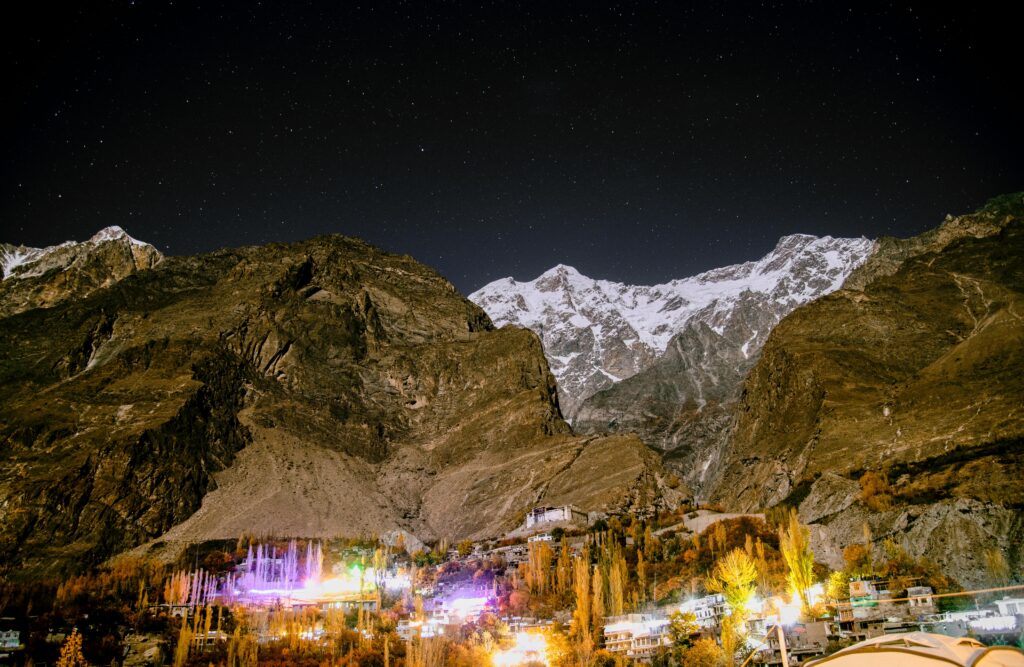
Renowned for its grand mountains, glistening clean lakes, and rich cultural legacy, the Hunza Valley is a stunning area in Pakistan’s Gilgit-Baltistan. Popular for sight-seers, hikers, and photographers, Hunza, commonly known as “Heaven on Earth,” is
Hunza presents an amazing experience with its snow-capped mountains, gorgeous terraced fields, friendly residents. Hunza has everything you would need—history, adventure, or peace in nature.
Topics included in this comprehensible guide will be best time to visit Hunza Valley, top tourist attractions, cultural heritage & traditions, adventure activities, and travel advice & accommodation.
— — —
The Reasons One Should Visit Hunza Valley
Beyond its obvious beauty, Hunza is a cultural gem full of historical legacy. You should so be sure to add it in your travel wish list:
The valley presents amazing views against Rakaposhi, Ultar Sar, and Passu Cones.
Historical Forts – Baltit Fort and Altit Fort, with over 700 years of history**; *Adventure Opportunities* – Trekking, paragliding, and camping are all within the region; Delicious Cuisine – indulge in Hunza bread, apricot oil, and local dried fruits. Furthermore among the Burusho and Wakhi people are those renowned for their friendliness and longevity.
—-|
The peak Hunza Valley: When should one visit?
Given Hunza’s changing temperature, time is quite important:
Spring is March through May. Here are beautiful cherry and apricot trees, and the temperature ranges from 10 to 20 degrees Celsius.
Perfect for people who photograph
With nice weather (15°C – 25°C) and lots of chances for outdoor activities like hiking and exploring, summer (June – August) is busiest travel season.
Verdant foliage – Picture-perfect backdrops less crowded, colder weather (5°C – 18°C). Fall (September–November).
#4. The December to February colder months. A snow-covered valley:
Invitingly chilly conditions; perfect for a peaceful off-season trip
The perfect months are September through October and April through June.
–
Most Popular Tourist Spot in Hunza Valley
From Karimabad – The Heart of Hunza, the major town, one can overlook the valley with amazing vistas.
One should see the landmark listed as a UNESCO World Heritage landmark, Bollit Fort.
One can find handcrafted items and dried fruits at local bazaars.
Attabad Lake, a turquoise wonder created from a 2010 landslide, is well-known for its remarkably blue waves.
Search for eateries and boat trips around lakefront areas.
Typical among the jagged mountain peaks that define the Passu Glacier & Cones are
Trekking to Passu Glacier or across the famously one of the most horrific constructions in the world, the Hussaini Suspension Bridge
Views of the whole valley from the ideal location for sunrise and sunset come from Duikar, sometimes known as Eagle’s Nest. Making a room reservation at a viewpoint hotel guarantees a remarkable experience.
Five-star Altit Fort & Village is older than Baltit Fort and features ancient architecture.
Investigate old houses and orchards**.
- Rakaposhi Viewpoint: An up-close view of the 7,788-meter-tall Rakaposhi mountain
Just fantastic is this halt on the **Karakoram Highway (KKH). The oldest settlement, Ganish hamlet boasts a water mill and an antique mosque spanning 400 years.
Learn about Hunza’s culture and customs. — –– Hunza presents a range of adventure sports for people seeking thrills: Hiking and treking destinations include Ultar Meadows Trek, Passu Glacier Trek, and Rakaposhi Base Camp Trek. Fly paragliding above Attabad Lake & Karimabad. An overnight camping trip would be best located on the adjacent Deosai Plains. Looking up at the evening sky Among the most beautiful routes available worldwide, cyclists thinking about this one —-| Long-keeping their language and culture include the Burushaski, Wakhi, and Shina people.
Many Ismaili Muslims are renowned for their educated and tolerant nature.
Many residents have passed the century thanks in large part to their diet and way of life.
Harvest Festivities, New Year’s Eve, Navroz**. —— Just one hour from Islamabad, Gilgit is the closest airport if you wish to fly. From there, one travels two hours to Hunza Valley. Traveling the Karakoram Highway (KKH) from Islamabad will take 14 to 16 hours. Starting your trip to Islamabad, fly from Lahore or Karachi. We advise private automobile hire if you want a flexible means of mobility.
Rideshares: NATCO, Silk Route – Hotels in Hunza Serena Hotel Hunza; Eagle’s Nest Hotel (Duikar) Two reasonably cost options are the Hunza Embassy Hotel and the Old Hunza Inn. The best places to really experience the local culture are the homestays, Mountain Story Guest House, and Darbar Hotel. – Made with whole wheat** Hunza Bread (Diram Phitti)** – Jam, juice, and dried apricots – Local Cuisine – What to Eat Chapshuro “Sea Buckthorn Juice, a superfood drink derived from locally grown buckthorn berries,” and ” Hunza-style beef pastry.” – Travel Tip for the Hunza Valley: Bring heavy clothing since even in the summer the evenings could be chilly.
Before snapping images, get permission and dress modestly to honor regional customs.
Other networks aren’t consistent, hence ✔ Acclimatize properly ( Hunza is 2,500 meters above sea level) and obtain a SIM card from SCOM or Zong. +/- The Hunza Valley transcends just a tourist destination with its unparalleled natural beauty and rich cultural legacy. For everyone inclined in trekking, historical research, or just leisure Hunza presents a unique experience. Why is this valley titled “The Shangri-La of Pakistan!”? Make your reservation now to learn! Fine. —
